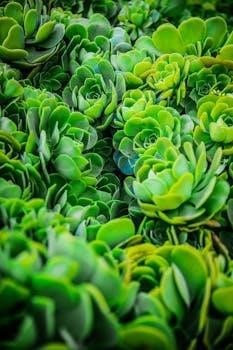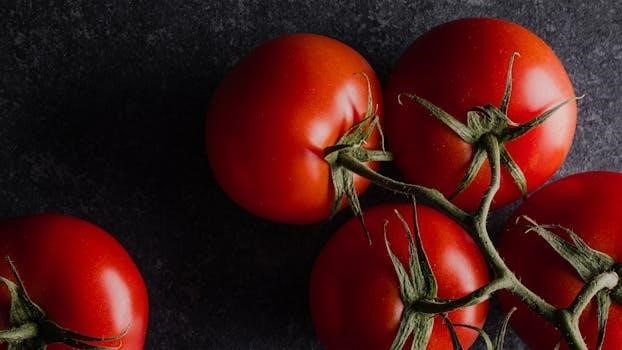Welcome to the world of Southern California gardening! This guide will help you navigate the unique climate and long growing seasons․ With approximately 270 days between frosts‚ you can enjoy a bountiful harvest․ Learn about optimal planting times and how to make the most of your garden throughout the year․
Understanding the Unique Climate
Southern California boasts a Mediterranean climate characterized by warm‚ dry summers and mild‚ wet winters‚ which allows for year-round gardening․ However‚ it is essential to understand the nuances of this climate to achieve success․ The region’s USDA hardiness zones range from 5 to 10‚ indicating diverse microclimates within Southern California․ The frost dates vary‚ with Los Angeles having an average first frost around December 15th and the last around February 1st․ This knowledge helps determine when to plant․ The long growing season‚ with about 270 days between frosts‚ offers ample opportunities for both summer and winter crops․ Water conservation is also a key consideration‚ as the region experiences periods of drought․ Understanding these factors will enable you to plan your garden effectively‚ choosing the right plants and planting times for a successful harvest․

Monthly Gardening Guide
This section provides a month-by-month guide for gardening in Southern California․ Learn what to plant‚ when to plant‚ and how to care for your garden throughout the year․ Follow this guide for a thriving garden․
January⁚ Preparing for the Season
January in Southern California marks the beginning of the gardening year‚ though it may still feel like winter․ It’s a time for planning and preparation rather than heavy planting․ Start by assessing your garden‚ noting areas that need improvement or soil amendments․ Clean up any remaining debris from the previous season and remove dead plants to prevent disease․ This is also a good time to prune deciduous fruit trees and shrubs․ Check your tools and make sure they are clean and sharp․ If you plan to plant new trees or shrubs‚ order them now so you will be ready when the time comes․ While it may be chilly‚ some early cool-season crops‚ like leafy greens‚ can be started indoors․ Pay attention to frost dates‚ as late frosts can still occur in some areas․ It’s also a good time to review your planting calendar and make plans for the coming months․ Prepare your garden beds‚ incorporating compost or other organic matter to enrich the soil․ Remember that Los Angeles has a first frost date of 12/15 and a last frost date of 2/1‚ so plan accordingly․
February⁚ Early Planting Starts
February in Southern California signals the start of active planting for many cool-season crops․ With the last frost date around February 1st in Los Angeles‚ it’s a good time to start planting salad greens and lettuces directly into the ground․ Carrots and other root vegetables can also be planted now․ It’s also a great month to begin sowing seeds indoors for warm-season vegetables‚ like tomatoes and peppers‚ which will be transplanted later․ Make sure to use a heat mat and grow lights to ensure they have ideal germination and growing conditions․ As the weather warms‚ you can also begin to plant peas and other climbing vegetables․ Pay attention to the weather forecast and protect tender seedlings from any late frosts․ Continue preparing garden beds‚ amending the soil as needed․ This is a great time to start planning your summer garden‚ noting where you want your tomatoes‚ peppers‚ and other warm-season favorites․
March-August⁚ Summer Season Planting
The period from March to August marks the peak of the summer growing season in Southern California․ This is the time to plant warm-season vegetables such as tomatoes‚ peppers‚ and eggplant once the threat of frost has passed․ Direct sow seeds for beans‚ cucumbers‚ and squash․ Regularly water your plants‚ especially during hot spells․ Consider using mulch to conserve moisture and suppress weeds․ Maintain your garden by thinning seedlings and providing support for climbing plants․ Remember that the planting deadline for the summer season is May 1st‚ so ensure that you have planted all your summer crops by that date․ Monitor for pests and diseases‚ taking preventative measures․ Harvest your crops regularly to encourage continued production․ This is also the time to enjoy the fruits (and vegetables!) of your labor‚ sharing your bounty with family and friends․
September-November⁚ Fall Season Planting
As the summer heat begins to subside‚ September to November ushers in the fall planting season in Southern California․ This period is ideal for planting cool-season crops such as lettuce‚ spinach‚ kale‚ and other leafy greens․ Direct sow seeds for carrots‚ radishes‚ and beets․ This is also a great time to plant broccoli‚ cauliflower‚ and peas․ Remember that the planting deadline for the winter season is November 1st․ Prepare your soil by amending it with compost․ Ensure your plants receive adequate water‚ especially when establishing․ Monitor for pests and diseases‚ taking preventative measures․ As temperatures drop‚ consider using row covers to protect more sensitive plants․ Harvest your crops regularly to encourage continuous growth․ Enjoy the cooler days and the fresh produce of your fall garden․

Specific Plant Care
Proper care is essential for thriving plants․ This section covers vital aspects like watering‚ pest control‚ and disease prevention․ Understanding these needs ensures a healthy and productive Southern California garden․ Regular attention will yield great results․
Watering Needs for Southern California

Watering in Southern California requires careful consideration due to the region’s unique climate․ While some areas might experience regular rainfall‚ many regions rely on irrigation․ The key is to water deeply and less frequently‚ encouraging roots to grow downward and search for moisture․ This method helps plants become more drought-tolerant and resilient․ For most plants‚ a deep watering once a week is adequate‚ but this can vary depending on plant type‚ soil composition‚ and the current weather․ During hotter months‚ you might need to water more frequently․ Vegetables‚ especially peppers‚ need consistent watering while establishing their roots․ Observe your plants for signs of stress like wilting or yellowing; these indicate they need more water․ Remember‚ overwatering can be as harmful as underwatering‚ leading to root rot and other diseases․ Pay close attention to your garden and adjust your watering schedule as needed․ Using mulch around the base of plants can help retain soil moisture and reduce the need for frequent watering․
Disease Prevention and Management
Disease prevention is a crucial aspect of successful gardening in Southern California․ The region’s warm climate can unfortunately also foster fungal and bacterial diseases․ To avoid such issues‚ ensure your plants have good air circulation by spacing them adequately․ This helps to reduce moisture buildup which is often the culprit․ It is also important to regularly inspect plants for any signs of disease‚ such as spots‚ wilting‚ or unusual growth․ Promptly removing any affected leaves or plants can stop diseases from spreading․ Another key method is crop rotation‚ which helps prevent disease buildup in the soil․ Additionally‚ always clean your gardening tools after each use to avoid cross-contamination․ Furthermore‚ be sure to remove all tomato‚ pepper‚ and eggplant plants from your garden plots between December 1 and March 1 to minimize the spread of diseases․ With proper prevention and management‚ you can keep your garden healthy and thriving․

Planting Resources
To maximize your gardening success‚ utilize planting calendars tailored for Southern California’s unique climate․ Knowing your first and last frost dates will guide your planting decisions․ Explore various tools for a bountiful harvest․
Utilizing Planting Calendars
Planting calendars are essential tools for Southern California gardeners․ These calendars‚ often month-by-month‚ provide guidance on when to sow seeds for optimal growth and harvest․ Charles B․ Ledgerwood’s calendar is a great resource for planning both summer and winter gardens․ These calendars consider the region’s specific USDA Hardiness Zones‚ which range from 5 to 10‚ acknowledging that planting times differ from Northern California․ A planting calendar helps you align your planting schedule with the best seasonal conditions for each crop․ It also aids in avoiding frost damage by indicating the average first and last frost dates‚ like December 15th and February 1st in Los Angeles․ By using these resources‚ you can be sure that you will grow the best garden possible․ You will be able to plant at the right time to avoid problems․ Planting calendars are a great resource for novice and expert gardeners․
Frost Dates in Southern California
Understanding frost dates is crucial for successful gardening in Southern California․ The average first frost date‚ which marks the beginning of the colder season‚ is around December 15th in Los Angeles․ Conversely‚ the last frost date‚ which signals the end of frost risk‚ typically falls around February 1st; These dates are not absolute‚ and it is important to monitor local weather for more accurate predictions․ Southern California generally enjoys a long growing season‚ with approximately 270 days between the last and first frost․ These dates help you plan when to start seeds indoors‚ when to transplant them outdoors‚ and when to expect the growing season to end․ Keep in mind that frost dates can vary based on your specific microclimate within Southern California․ It is important to plan carefully to avoid losing your plants to frost․